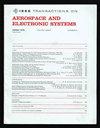相干分布式毫米波雷达的高分辨率DOA估计
IF 5.7
2区 计算机科学
Q1 ENGINEERING, AEROSPACE
IEEE Transactions on Aerospace and Electronic Systems
Pub Date : 2025-01-20
DOI:10.1109/TAES.2024.3525444
引用次数: 0
摘要
实现高角分辨率估计是增强环境感知和准确探测扩展目标的关键。然而,将大孔径雷达系统作为单一传感器实现面临着重大的技术和经济挑战。雷达网络由多个单独的雷达传感器组成,为这些障碍提供了一个有希望的解决方案。本文提出了一种适合于相干分布式毫米波雷达系统的高分辨率到达方向(DOA)估计方法。我们的方法利用多输入多输出技术和分布式阵列,构建一个虚拟稀疏阵列,通过特定的相关变换,能够合成一个完整的均匀阵列协方差矩阵。此外,我们引入了一种直接寻角的联合优化方法,该方法利用稀疏性和低秩性有效地解决了大规模优化问题,从而绕过了传统的矩阵重构和DOA估计的顺序步骤。我们采用乘法器的交替方向方法来保证可靠的收敛。我们提出的模型和方法已经通过全面的仿真得到了广泛的验证,突出了它们在分布式雷达系统领域的优势。本文章由计算机程序翻译,如有差异,请以英文原文为准。
High Resolution DOA Estimation of Coherent Distributed Millimeter-Wave Radar
Achieving high angular resolution estimation is essential for enhancing environmental perception and accurately detecting extended targets. However, implementing a large aperture radar system as a single sensor faces significant technical and economic challenges. Radar networks, comprising multiple individual radar sensors, offer a promising solution to these obstacles. In this article, we propose a method for high resolution direction-of-arrival (DOA) estimation tailored for coherent distributed millimeter-wave radar systems. Our approach leverages multiple-input multiple-output technology and distributed arrays to construct a virtual sparse array capable of synthesizing a full uniform array covariance matrix through specific correlation transformation. Furthermore, we introduce a joint optimization method for directly angle finding that efficiently addresses large-scale optimization problems by exploiting both sparsity and low-rank properties, thereby circumventing the traditional sequential steps of matrix reconstruction and DOA estimation. We employ the alternating direction method of multipliers to ensure reliable convergence. Our proposed model and method have been extensively validated through comprehensive simulations, highlighting their advantages within the realm of distributed radar systems.
求助全文
通过发布文献求助,成功后即可免费获取论文全文。
去求助
来源期刊
CiteScore
7.80
自引率
13.60%
发文量
433
审稿时长
8.7 months
期刊介绍:
IEEE Transactions on Aerospace and Electronic Systems focuses on the organization, design, development, integration, and operation of complex systems for space, air, ocean, or ground environment. These systems include, but are not limited to, navigation, avionics, spacecraft, aerospace power, radar, sonar, telemetry, defense, transportation, automated testing, and command and control.

 求助内容:
求助内容: 应助结果提醒方式:
应助结果提醒方式:


